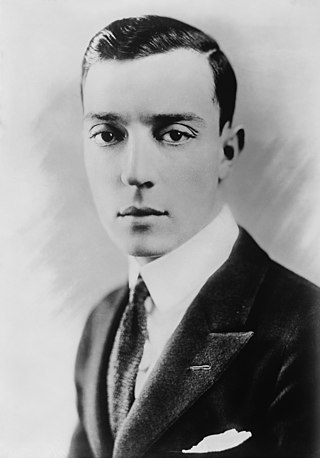
Joseph Frank "Buster" Keaton was an American actor, comedian and filmmaker. He is best known for his silent film work, in which his trademark was physical comedy accompanied by a stoic, deadpan expression that earned him the nickname "The Great Stone Face". Critic Roger Ebert wrote of Keaton's "extraordinary period from 1920 to 1929" when he "worked without interruption" as having made him "the greatest actor-director in the history of the movies". In 1996, Entertainment Weekly recognized Keaton as the seventh-greatest film director, writing that "More than Chaplin, Keaton understood movies: He knew they consisted of a four-sided frame in which resided a malleable reality off which his persona could bounce. A vaudeville child star, Keaton grew up to be a tinkerer, an athlete, a visual mathematician; his films offer belly laughs of mind-boggling physical invention and a spacey determination that nears philosophical grandeur." In 1999, the American Film Institute ranked him as the 21st-greatest male star of classic Hollywood cinema.

The General is a 1926 American silent slapstick action comedy film released by United Artists. It was inspired by the Great Locomotive Chase, a true story of an event that occurred during the American Civil War. The story was adapted from the 1889 memoir The Great Locomotive Chase by William Pittenger. The film stars Buster Keaton, who also directed it along with Clyde Bruckman.

Educational Pictures, also known as Educational Film Exchanges, Inc. or Educational Films Corporation of America, was an American film production and film distribution company founded in 1916 by Earle Hammons (1882–1962). Educational primarily distributed short subjects; it is best known for its series of comedies starring Buster Keaton (1934– 37) and the earliest screen appearances of Shirley Temple (1932–34). The company ceased production in 1938, and finally closed in 1940 when its film library was sold at auction.
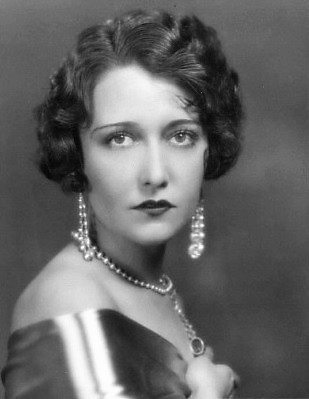
Dorothy Sebastian was an American film and stage actress.
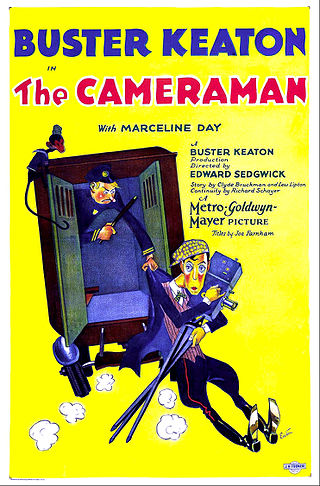
The Cameraman is a 1928 American silent romantic comedy film directed by Edward Sedgwick and an uncredited Buster Keaton. The picture stars Keaton and Marceline Day.
Charles Lamont was a prolific filmmaker, directing over 200 titles and producing and writing many others. He directed several Abbott and Costello comedies and many Ma and Pa Kettle films.
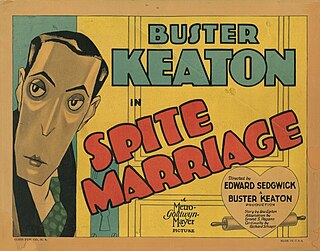
Spite Marriage is a 1929 American silent comedy film co-directed by Buster Keaton and Edward Sedgwick and starring Keaton and Dorothy Sebastian. It is the second film Keaton made for MGM and his last silent film, although he had wanted it to be a "talkie" or full sound film. While the production has no recorded dialogue, it does feature an accompanying synchronized score and recorded laughter, applause and other sound effects in some scenes. Keaton later wrote gags for some up-and-coming MGM stars like Red Skelton, and from this film recycled many gags, some shot-for-shot, for Skelton's 1943 film I Dood It.

Love Nest on Wheels is a 1937 Educational Pictures short subject directed by Buster Keaton and Charles Lamont. The film borrows heavily from Keaton's 1918 film The Bell Boy.

Earle W. Hammons, known professionally as E. W. Hammons, was an American film producer,. He produced more than 220 films between 1921 and 1938.
Tars and Stripes is a 1935 American Educational Pictures short comedy film directed by and starring Buster Keaton. The film was shot at the Naval Training Center San Diego, California.
Three on a Limb is a 1936 American short comedy film directed by Charles Lamont and starring Buster Keaton.
Grand Slam Opera is a 1936 American short comedy film starring Buster Keaton and produced by Educational Pictures.
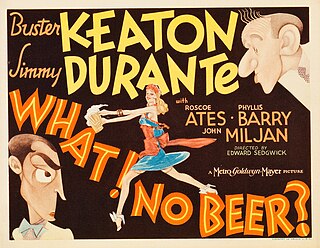
What - No Beer? is a 1933 Pre-Code comedy film released by Metro-Goldwyn-Mayer directed by Edward Sedgwick and starring Buster Keaton and Jimmy Durante. MGM had also paired Keaton and Durante as a comedy team during this period in The Passionate Plumber and Speak Easily.

The Passionate Plumber is a 1932 American pre-Code comedy film directed by Edward Sedgwick, and starring Buster Keaton, Jimmy Durante, and Irene Purcell. The screenplay by Laurence E. Johnson and Ralph Spence is based on the 1926 play Dans sa candeur naïve by Jacques Deval. It is the second screen adaptation of the play, following the 1928 silent film The Cardboard Lover. It later was remade in 1942 as Her Cardboard Lover.

The Buster Keaton Story is a 1957 American biographical drama film directed by Sidney Sheldon and written by Sidney Sheldon and Robert Smith, following the life of Buster Keaton. The film stars Donald O'Connor, Ann Blyth, Rhonda Fleming, Peter Lorre, Larry Keating and Jackie Coogan. It was released on April 21, 1957, by Paramount Pictures. The film was described by AllMovie as "sublimely inaccurate" regarding details of Keaton's life. It was produced by Paramount Pictures, which paid Keaton $50,000 for the rights to his life story.

Doughboys is a 1930 American Pre-Code comedy film starring Buster Keaton. It was Keaton's second starring talkie vehicle and has been called Keaton's "most successful sound Picture." A Spanish-language version was also made under the title, De Frente, Marchen.
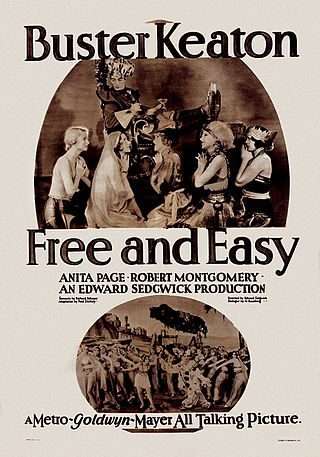
Free and Easy is a 1930 American pre-Code comedy film starring Buster Keaton. It was Keaton's first leading role in a talking motion picture.

Jeffrey Vance is an American film historian and author who has published books on movie stars including Buster Keaton and Charlie Chaplin.
Elsie Ames was an American comic dancer and film actress. Between 1937 and 1974 she acted in 15 films. She is best known as the female film partner of Buster Keaton.
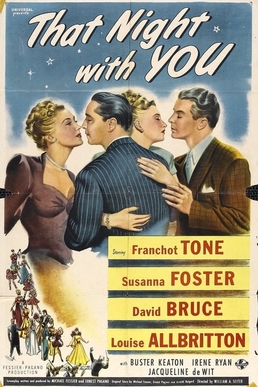
That Night With You is a 1945 American comedy film directed by William A. Seiter and starring Susanna Foster, Franchot Tone and Louise Allbritton. Produced and distributed by Universal Pictures, it featured Buster Keaton in a supporting role. At one stage the film used the working title Once Upon a Dream.















